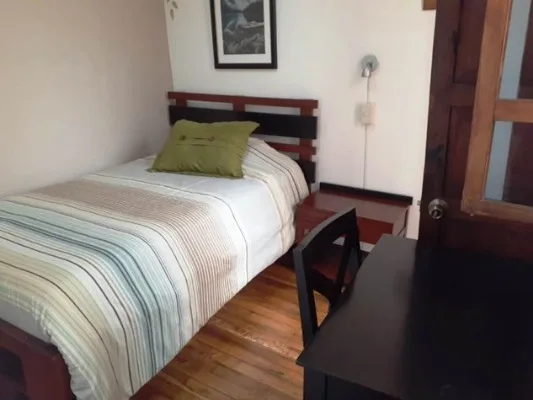CUENCA DIGESTDespite increase in number of vehicles, Cuenca air quality holds steady in 2009; use of cleaner diesel fuel credited
The director of Cuenacaire, Rolando Arpi, says that Cuenca’s air quality has held steady in 2009 and has shown slight improvements in some areas despite an increase in the number of vehicles on the roads.
Cuencaire, created in 2007 to measure air pollution, maintains two dozen monitoring stations throughout the city and in surrounding areas, that record levels of carbon monoxide (CO), sulfur dioxide (SO2), nitrogen oxide (NOx), carbon dioxide (CO2), methane (CH4) and nitrous oxide (N2O) and particulate matter with diameter less than 10 micrometers.
According to Arpi, one reason for the better measurements is the introduction of cleaner diesel fuel. “The amount of impurities in the diesel, especially sulfur, has been greatly reduced and this means improvement for the air.”
One major concern for Arpi is that the number of riders in vehicles is declining. “In 2007, our statistics show that there were five passengers in each vehicle. That number has dropped to three, so we need to educate the public about the importance of car pooling.”
number of riders in vehicles is declining. “In 2007, our statistics show that there were five passengers in each vehicle. That number has dropped to three, so we need to educate the public about the importance of car pooling.”
According to Cuencaire readings, areas with the worst air quality are the two blocks of Calle Presidente Cordova just east of San Francisco Plaza and area surrounding Vicente Corral Moscoso Hospital. Areas with the cleanest air are in the foothills of the Cajas Mountains and Turi.
In a 2006 survey of Latin American cities, Cuenca ranked in the top 10% for air quality for cities in its population category.
IMMIGRATION SERVICES TO BE EXPANDED IN CUENCA
Responding to growing numbers of Ecuadorians and foreigners who require immigration services, the Ministry of Foreign Affairs has announced it will expand its Cuenca operations in 2010.
Southern Ecuador has the highest number of former residents living overseas, per capita, of any region of the country. Many of these residents are returning home and require immigration services. “Now, they are required to travel to Quito or Guayaquil, and this is a hardship for many of them,” said Ana Lucia Serrano, regional secretary for the foreign affairs ministry. Serrano also noted the growing number of foreign residents moving into the area, especially Cuenca, who also require services.
The foreign affairs office did not announce an opening date for the Cuenca office but said that it would be early in 2010.
THOUSANDS OF CITY PARKING FINES REMAIN UNCOLLECTED
Six years after the implementation of a comprehensive city street parking system, thousands of parking fines, ranging from $10 to $2,000 remain uncollected. The director of the Cuenca parking authority estimates the outstanding total is $1,590,000.
Vladimir Argudo, who heads the parking program, says that the number of unpaid fines is “unacceptable” and that his office is working on methods to increase collections and stop abuses.
"It is estimated that uncollected fines amount to more than $250,000 a year since we began the program,” Argudo said.
FLOWER MARKET PROJECT MOVES FORWARD AFTER LONG DELAY
Cuenca’s Barranco Foundation has awarded a contract for the construction of 16 sales stalls at the Plaza de las Flores at Calles Sucre and Aguirre, opposite the cathedral. The announcement comes almost a year-and-a-half after new permanent stalls were torn down following public criticism of their design.
According to Foundation director Benjamin Cordero, the new design requires that the plastic and metal stalls be portable and be dismantled when the market closes each day. “It is important that the plaza be open when the market is not in operation so the space can be used for cultural and social events,” Cordero said.
The sales stalls will be arranged in two rows, each holding 10 large buckets of floral arrangements. Each stall will measure one by two meters. Plans for the new flower market design require free access to the square, the adjacent convent and the stores operating on the outside of the convent building.
AEROGAL BEGINS SERVICE TO NEW YORK; TAME REDUCES SERVICE TO MANTA AND LOJA
Ecuadorian airline AeroGal began non-stop service to New York’s JFK airport Dec. 10. It is the airline’s second U.S. route, having initiated service to Miami earlier in the year. The New York service is the first offered by an Ecuadorian airline since the defunct Ecuadoriana ended operations 10 years ago.
Gabriela Sommerfeld, AeroGal chief executive, said that the flights meet a critical demand. “There are as many as two million Ecuadorians living in the New York and New Jersey area. Our first priority is to make it easier for them to travel between Ecuador and the U.S.,” she said. “We also recognize the growing popularity of Ecuador as a tourist destination and we intend to serve this need as well.”
According to Sommerfeld, AeroGal is looking at ways to improve connections for Ecuador-to-U.S. travelers to major cities in Ecuador. "We want to bring more tourists to Quito, Guayaquil. Cuenca, and the Galapagos and are considering more frequent flights.”
In other airline news, government-operated Tame airlines, has announced it is ending its Quito-to-Manta and Guayaquil-to-Loja service. The airline cited lack of passengers for the decision.
Photo caption: Cuenca's famous flower market will soon have a new look.





















